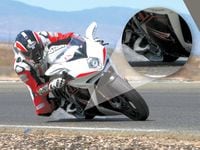Traction limits can be hard to reckon for some riders. Understanding how traction is created can introduce some clarity. Traction is a byproduct of the brew of chemicals in the rubber compound, coupled with how cleverly the tire carcass is constructed and shaped, plus proper inflation, tread depth, and tire temperature, which invariably varies with different rubber compounds.
Heat a mounted tire to its optimum operating temperature, tilt it to 45 degrees, and then apply ever-increasing pressure to it. At some point the tire will eventually slip—the load at the exact slipping point represents 101 percent (or so) of the tire's static-grip limit.
Achieving maximum traction while in motion is something quite different. As the tire grips, it also wears. What “wears out” are the various chemicals, oils, waxes, and pigments that bind the rubber together. Abrasion and heat “cook” these compounds off. You’ve noticed the bluish-purple color of a tire that’s been subjected to hard cornering? That’s called “blooming,” and it’s caused by residue from the chemicals that have been leached out of the tire by heat. It takes very little abrasion to wear the bloom off—maybe a lap.
Oily substances—blended in sufficient quantity to maintain the rubber’s flexible and compliant character—support its ability to mate with the road’s surface. When these substances cook off, the tire can become dry and slippery, like dead skin peeling from a sunburn. That dry layer must be cleaned off to expose fresh skin—in this case, fresh rubber. Cleaning it off requires abrasion. The necessary abrasion is provided by tire slippage. Tire engineers suggest that roughly 15-percent longitudinal slippage maintains friction-value peaks and peak operating temperature. Don’t mistake this slippage as a slide, however. The bike still holds its line; it slips just enough to clean the tires.
Depleted rubber must be scrubbed from both front and rear tires. Without any power to drive it, the front tire relies on three forces to uncover fresh rubber: 1) slip angle; 2) side-grip friction; and 3) abrasion from braking. In the steady-state portion of a corner—after braking and before acceleration—both tires clean up from slip angle and side-grip abrasion alone.
A motorcycle’s tendency is to always go straight until some outside force influences it to turn. The turned-in front wheel is that influence; this creates abrasion resistance that forces the bike to enter and hold its arc through the corner. But the tires are also slipping sideways toward the outside—that’s the slip angle.
Slip angle is interesting: Imagine you were able to freeze the lean and the turned-in front wheel angle you hold while going through a corner. If you got off the bike and pushed it, you would find the line through the corner would be much tighter than if you were riding at speed. But that’s not the whole picture.
Camber force is another factor that plays a part in traction. It works like this: On both tires, the outside of the patch (the chicken-strip side) is on a tighter radius than the side closest to the tire’s centerline. Think of a playground merry-go-round: The outside edge is traveling farther in the same amount of time than the center and is therefore going faster. Similarly, the side of the contact patch closest to the inside of the corner is turning slower and in effect dragging, which creates rubber-cleansing abrasion and also helps the bike stay on its line. (For a more detailed explanation, look up the technical definition of camber thrust or camber force.)
In any corner, at any speed sufficient to keep the bike moving upright and balanced, the tires are always at least slightly slipping. You wouldn’t get through corners—or ever have to replace your tires—if they didn’t slip.











/cloudfront-us-east-1.images.arcpublishing.com/octane/VZZXJQ6U3FESFPZCBVXKFSUG4A.jpg)
/cloudfront-us-east-1.images.arcpublishing.com/octane/QCZEPHQAMRHZPLHTDJBIJVWL3M.jpg)
/cloudfront-us-east-1.images.arcpublishing.com/octane/HXOUJXQWA5HBHGRO3EMJIGFMVI.jpg)

/cloudfront-us-east-1.images.arcpublishing.com/octane/3TIWWRV4JBBOLDVGRYECVVTA7Y.jpg)
/cloudfront-us-east-1.images.arcpublishing.com/octane/KIX5O23D5NAIBGFXBN3327DKZU.jpg)
/cloudfront-us-east-1.images.arcpublishing.com/octane/7GJYDUIPXRGMTMQKN6ONYOLBOU.jpg)
/cloudfront-us-east-1.images.arcpublishing.com/octane/MUQLOVLL2ZDGFH25ILABNBXKTI.jpg)
/cloudfront-us-east-1.images.arcpublishing.com/octane/TNOU5DNE2BC57MFPMGN2EIDXAM.jpg)
/cloudfront-us-east-1.images.arcpublishing.com/octane/GTCXACQGJ5HAPDTGWUQKDEH44E.jpg)
/cloudfront-us-east-1.images.arcpublishing.com/octane/S35YGSEMEZB4BLTDJTSZPF4GLA.jpg)
/cloudfront-us-east-1.images.arcpublishing.com/octane/5UOT6HPX2JFMRJAX6EH45AR4MQ.jpg)
/cloudfront-us-east-1.images.arcpublishing.com/octane/OKWOJWAKP5EP3OACCRRWPCIX2Q.jpg)
/cloudfront-us-east-1.images.arcpublishing.com/octane/2WF3SCE3NFBQXLDNJM7KMXA45E.jpg)
/cloudfront-us-east-1.images.arcpublishing.com/octane/G4MG6OUCJNBSHIS2MVVOTPX65E.jpg)
/cloudfront-us-east-1.images.arcpublishing.com/octane/IIGGWFOTOJGB7DB6DGBXCCMTDY.jpg)
/cloudfront-us-east-1.images.arcpublishing.com/octane/QSTCM6AVEZA5JJBUXNIQ3DSOF4.jpg)
/cloudfront-us-east-1.images.arcpublishing.com/octane/U4I7G625B5DMLF2DVIJDFZVV6M.jpg)
/cloudfront-us-east-1.images.arcpublishing.com/octane/B6XD6LS6IVCQPIU6HXDJSM3FHY.jpg)
/cloudfront-us-east-1.images.arcpublishing.com/octane/ICL63FEDDRDTTMINYICCEYGMDA.jpg)
/cloudfront-us-east-1.images.arcpublishing.com/octane/FCGZHQXRBZFLBAPC5SDIQLVF4I.jpg)
/cloudfront-us-east-1.images.arcpublishing.com/octane/WNOB6LDOIFFHJKPSVIWDYUGOPM.jpg)

/cloudfront-us-east-1.images.arcpublishing.com/octane/X33NU3E525ECRHXLNUJN2FTRKI.jpg)